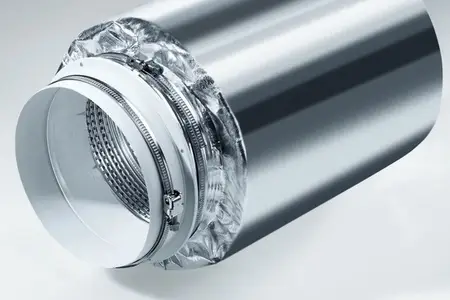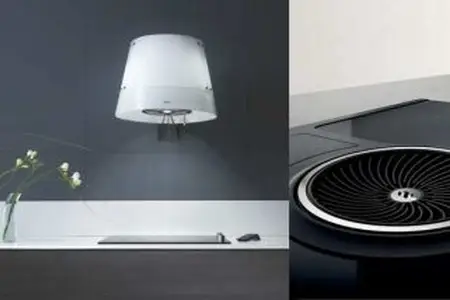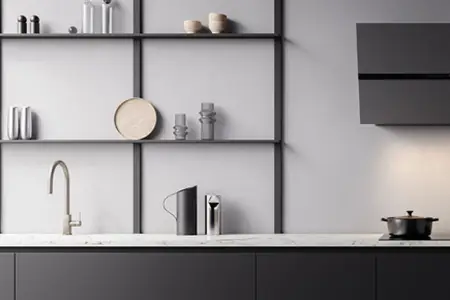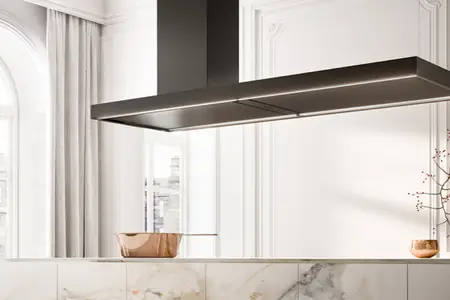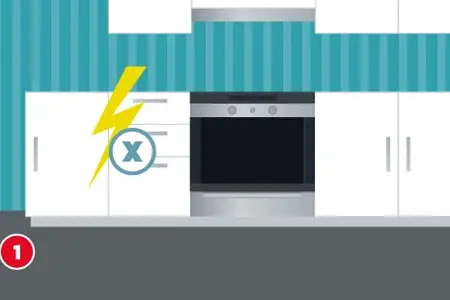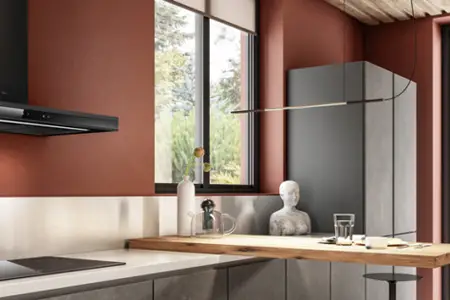Choosing between a cooktop extractor and a classic range hood can be a difficult decision, as both systems have their own advantages and disadvantages. In this article, we examine the differences, benefits, and potential drawbacks of both options to help you decide which solution makes more sense for your kitchen. We’ll also look at various types of extractors, such as classic range hoods and modern downdraft extractors, and discuss aspects like visibility in the kitchen, noise generation, and placement.
What is a Cooktop Extractor?
A cooktop extractor, also known as a downdraft extractor hood, is a ventilation unit that is integrated into the cooktop or installed directly beside it. The extraction occurs downward at the end of the hood. Instead of pulling air upward, as is the case with classic hoods, a cooktop extractor draws steam and odors downward. A downdraft ventilator is a special type of cooktop extractor that is directly integrated into the cooktop and efficiently draws stale air and cooking fumes downward.
The downdraft extractor in cooktops is an increasingly popular feature in modern kitchens. Instead of a classic range hood, the extractor draws vapors and odors directly from the cooktop, offering a space-saving and elegant solution. However, as modern and practical as this technology may sound, it also has its downsides. In this blog, we explore the disadvantages of cooktop extractors and what you should consider before making a purchase.

Advantages of Cooktop Extractors
The cooktop extractor offers several advantages that make it an attractive choice for modern kitchens. One of the most important benefits is space saving. Since the extractor is directly integrated into the cooktop, it doesn’t require additional kitchen space. This makes it ideal for small kitchens or kitchens with limited space.
Another advantage is easy cleaning. The cooktop extractor is easy to clean as it has no visible parts that can accumulate dust and grease. This significantly reduces cleaning effort and ensures a consistently clean and hygienic kitchen.
Furthermore, the cooktop extractor is also quieter than classic range hoods. Since the motor is placed directly under the cooktop, the motor noise is better absorbed, leading to a quieter cooking environment. This is particularly advantageous in open-plan kitchens where a quiet atmosphere is desired.
How Cooktop Extractors Work
The cooktop extractor works by drawing cooking vapors and odors directly downward into the extractor. This is accomplished through a powerful motor integrated into the cooktop. The motor draws in the air and passes it through a filter that removes grease and odor particles. The cleaned air is then either recirculated back into the room or vented outside, depending on the model.
Some cooktop extractor models are equipped with additional functions that increase comfort and efficiency. These include features such as a timer function that automatically turns off the extractor after a set time, or an automatic cleaning function that cleans the filter independently. These functions help minimize maintenance effort and extend the device’s lifespan.
Difference between Cooktop Extractor and Classic Hood Extractor
The cooktop extractor differs from classic extractor hoods in several aspects. One of the most noticeable differences is space efficiency. Classic extractor hoods require additional space on the wall or ceiling of the kitchen, while the cooktop extractor is directly integrated into the cooking surface, thus not requiring any extra space. This is particularly advantageous in small kitchens where every centimeter counts.
Another difference lies in the operating method. Classic extractor hoods draw cooking vapors and odors upward into the exhaust, while the cooktop extractor draws them directly downward. This can be more efficient in some cases, as vapors and odors are captured immediately before they can spread throughout the room.
Furthermore, the cooktop extractor is often quieter and easier to clean than classic extractor hoods. Since the motor is placed directly under the cooktop, noise is better absorbed, leading to a quieter cooking environment. Cleaning is also easier as there are no visible parts that can accumulate dust and grease.
Overall, the cooktop extractor offers a modern and space-saving alternative to classic extractor hoods, which can be particularly beneficial in small kitchens or open-plan kitchen layouts.
Disadvantages in Extracting Steam and Grease
The efficiency in extracting steam (vapor and odors) and grease is a crucial factor when choosing the right extractor. Compared to conventional hoods, cooktop extractors can face certain challenges.
Limited Grease Separation
With a classic extractor hood, steam rises naturally upward and is extracted by the hood at the ceiling or wall. This ensures very efficient grease separation as the steam follows its natural upward path. However, with a cooktop extractor, the steam is drawn sideways or downward, which isn’t always as efficient.
Issues with Large Pots or Pans
Particularly with large pots or pans, the steam might not be completely captured by the extractor. This is because the steam cannot be directed sideways or downward quickly enough and instead rises into the room before it can be captured.
Example: When cooking on multiple burners simultaneously or using larger pans, not all steam might be extracted, resulting in grease deposits in the kitchen.
Tip: When purchasing, ensure that the cooktop extractor has high extraction power and is designed for the number of cooking zones and pan sizes you regularly use.
Challenges with Heavy Steam Production
Another disadvantage concerns heavy steam production during certain cooking activities, such as boiling water, frying meat, or deep-frying. Since the cooktop extractor must direct steam sideways or downward, it may not be extracted quickly enough and rise into the room. A downdraft extractor can serve as an alternative solution here, as it extracts steam directly behind the cooktop, enabling more efficient steam removal.
Issues with Multiple Cooking Zones
When using multiple cooking zones simultaneously, there’s a risk that the extractor won’t have sufficient capacity to remove all vapors and odors. This leads to a higher risk of steam escaping into the room and affecting air quality.
Example: When cooking stews or frying on multiple burners simultaneously, the extractor might be overwhelmed, resulting in steam and odors remaining in the kitchen.
Tip: Check the manufacturer’s performance specifications to ensure the cooktop extractor works effectively even during intensive cooking processes.
Limited Performance During Intensive Cooking
One of the biggest disadvantages of a downdraft extractor in the cooktop is the potentially limited performance when cooking with intensive steam generation. Since the extractor must draw the steam downward or sideways, it may reach its limits during certain cooking processes.
Steam-Intensive Cooking Processes
During intensive cooking processes like searing, deep-frying, or boiling large quantities of water, strong amounts of steam are generated that may not be drawn downward quickly enough. Especially with larger pots or pans, the steam tends to rise upward first before being captured by the extractor.
Example: When cooking on multiple burners simultaneously, steam from back burners cannot always be captured optimally, which can result in odors and vapors remaining in the kitchen.
Tip: If you regularly cook intensively, make sure the cooktop extractor has sufficient power or consider whether a conventional hood might be the better choice.
High Space Requirements Below the Cooktop
A downdraft extractor not only requires space on the work surface but also considerable room under the cooktop for the ventilation unit and air ducting. This leads to a loss of storage space in the base cabinet area, which can be particularly problematic in small kitchens.
Storage Loss in Base Cabinet
Since the extractor technology is housed in the base cabinet, drawers or shelves are either unavailable or severely limited. For kitchens that already offer little storage space, this is a significant disadvantage.
Example: In a kitchen with limited space, the cooktop extractor can displace valuable storage space that could be used for dishes, pots, or pans.
Tip: Before purchasing, carefully plan how much storage space you need under the cooktop and whether you can compensate for the loss of space through alternative solutions.
Complex Installation
Installing a cooktop extractor is significantly more complex and expensive than installing a conventional hood. The installation requires precise planning and possibly structural modifications, especially for air ducting.
Air Ducting Requirements
If you choose a model with exhaust air operation, the exhaust pipe must be routed through the base cabinet and possibly over a longer distance to the outside. This can be challenging in some kitchens and significantly increase installation costs.
Example: In a kitchen without a direct exterior wall, installing an exhaust system for the cooktop extractor is particularly complex and expensive, as long exhaust pipes need to be installed.
Tip: Carefully consider whether your kitchen is suitable for a cooktop extractor and calculate the installation costs in advance.
Higher Acquisition Costs
Cooktop extractors are modern, high-quality technology that is accordingly more expensive than conventional hoods. The acquisition costs can be substantial depending on the model and brand.
Price Differences Compared to Conventional Hoods
Prices for cooktop extractors are typically in the four-digit range, making them a significantly more expensive solution than classic exhaust hoods. Higher installation costs often add to this.
Example: While a standard exhaust hood is available from 200 to 400 euros, prices for cooktop extractors often start at 1,500 euros and can reach 3,000 euros or more for premium models.
Tip: If you have a limited budget, carefully compare the costs of the cooktop extractor with those of a conventional hood to ensure the investment is worth it for you.
Noise Generation
Another disadvantage of the cooktop extractor can be noise generation. Since the extractor is located directly at the cooktop, the operating noise is often closer to the cooking area and can seem louder than with a classic hood mounted higher up.
Operating Volume
While modern cooktop extractors generally operate quietly, they can produce disturbing noise at high power. This can be particularly unpleasant in open-plan kitchens since the cooktop extractor works directly in the room.
Example: During intensive cooking on multiple burners, the extractor must operate at high speed, leading to increased noise generation.
Tip: Pay attention to the manufacturer’s decibel specifications when purchasing and choose a model that operates particularly quietly at low and medium power levels.

